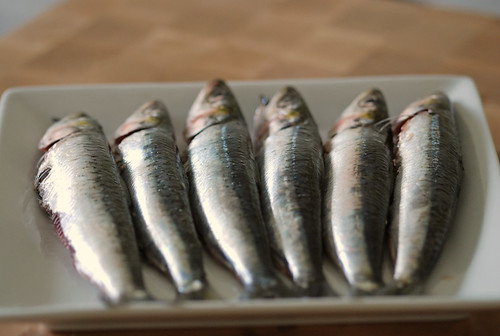Morocco - Sardine capital of the world.The word sardine is an imprecise term referring to any number of small, silvery saltwater fish related to the herring and found throughout the world. Fish labeled as "sardines" include sprats, brisling and pilchards.
Frequently caught off the Mediterranean coast and eaten in abundance in Spain, Greece, Portugal, Italy and Morocco, you can also find sardines from the Atlantic, the Pacific, the East Coast of South Africa and beyond.
Sardines tend to travel in large schools close to the water's surface and are harvested fresh in the summer. The name sardine may be a reference to the Sardinian coast, where pilchards were one of the first fish to be packed in oil.



Here's something you probably didn't know about Morocco. Morocco is the world's largest exporter of sardines. And now the little fish is about to make further contributions to the economy as Morocco replaces Venezuela as main supplier of sardines to Brazil.
Morocco became the main supplier of sardines to Brazil in the first two months of the year, taking over the market share left by Venezuela, which has stopped exporting the fish. Brazil had purchased 8,500 tonnes of the Moroccan fish up to February.
"Morocco tends to benefit as, behind Venezuela, it is the country that most exports sardines to Brazil," stated Luiz Eduardo Carvalho Bonilha, general coordinator of Industrial Fishery of the Special Secretariat of Aquiculture and Fishery (Seap), a federal government organization. Venezuela, according to Bonilha, is turning its fishery to the foreign market, as the country has reduced sardine fishing to protect its shoals.
Venezuela supplied 31,800 tonnes of sardine to Brazil in 2005, according to figures supplied by the Foreign Trade Secretariat (Secex). The figures include frozen and pickled sardines. The volume supplied by the South American country represented 94.6% of the total imported by Brazil in the period. According to Bonilha, the full volume may be supplied by Morocco and also by the United States and Russia. "But Morocco is the country, outside South America, that stands out most in our exports," he said.
Around one month ago sardine import tariffs were reduced to zero. Before that, the tariff for import of the product from countries like Morocco was 2%, but the government decided to bring benefits to other nations that export the product, giving them the same advantages as Venezuela, as a South American country, had. To supply the domestic demand in Brazil, the tariff will remain zeroed not only during the period in which sardine fishing is prohibited in the country, due to reproduction and growth of the fish, but also throughout the year.
Up to last year, however, sales of the Moroccan product to Brazil were not so impressive. Morocco shipped 962 tonnes to the country, which represented 2.8% of the total imported. Even so, Morocco was the second foreign supplier of sector products in the sector. Exports generated revenues of US$ 572,000 to the Moroccans.
This year, just in the first two months, Moroccan sardine sales to Brazil reached US$ 4.7 million. The country has become the largest supplier of the product to Brazil. The domestic market imported a total of US$ 5.6 million in sardines, canned and frozen, between January and February. In terms of volume, Morocco answered for 83.3% of Brazilian imports, which totalled 10,200 tons.







